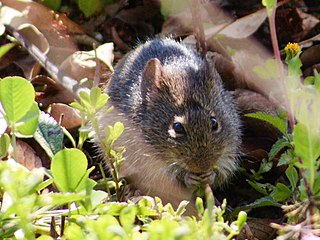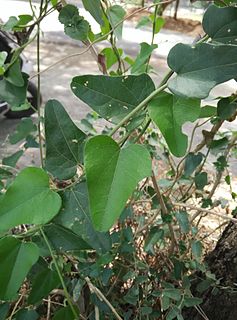Related Research Articles

The spotted handfish is a rare Australian fish in the handfish family, Brachionichthyidae, classified as critically endangered on the IUCN Red List 2020. It has a highly restricted range, being found only in the estuary of Derwent River, Tasmania, and nearby areas, with the main threat to its existence being an invasive species, the Northern Pacific seastar.

Handfish are any anglerfish within the family Brachionichthyidae, a group which comprises five genera and 14 extant species. These benthic marine fish are unusual in the way they propel themselves by walking on the sea floor rather than swimming.

The noble family of the Waldgraves or Wildgraves descended of a division of the House of the Counts of Nahegau in the year 1113.

The rufous hare-wallaby, also known as the mala, is a small macropod found in Australia. It was formerly widely distributed across the western half of the continent, but naturally occurring populations are now confined to Bernier Island and Dorre Island Islands off Western Australia.

Lagorchestes is a genus containing all but one of the species referred to as hare-wallabies. It has four species, two of which are extinct:

Glaphyridae is a family of beetles, commonly known as bumble bee scarab beetles. There are eight extant genera with about 80 species distributed worldwide and two extinct genera described from the Aptian aged Yixian Formation of China. There are cases of flower-beetle interactions, in the southeast Mediterranean region between red bowl-shaped flowers and Glaphyridae beetles.
The hairy harvest mouse is a species of rodent in the family Cricetidae found only in Mexico.

The hairy fruit-eating bat is a species of bat in the family Phyllostomidae. It is endemic to Mexico. It is threatened by habitat loss.

The Honduran fruit-eating bat is a species of bat in the family Phyllostomidae. It is found in El Salvador, Honduras, and Nicaragua.

The big-eared horseshoe bat is a bat species within the Rhinolophidae native to China, India, Indonesia, Laos, Malaysia, Nepal, Pakistan, the Philippines, Thailand, and Vietnam.

Lathyrus hirsutus is a species of wild pea known by several common names, including Caley pea, singletary pea, hairy vetchling, and Austrian winter pea. It is native to Europe, North Africa, and much of Asia, and it is known from other continents, including North America, as an introduced species. This is an annual herb producing a winged stem and leaves each made up of two leaflike leaflets with a branching, coiled tendril. The inflorescence holds one or two pink, blue, or bicolored pea flowers each 1 to 1.5 centimeters wide. The fruit is a dehiscent legume pod covered in hairs with each hair growing from a minute bulbous base. The rest of the plant is generally hairless.

The southern cotton rat is a rodent species in the family Cricetidae. It is found from southern Chiapas in Mexico through Central America, except for Belize, and as far east as northern Colombia and Venezuela. It lives in tropical rainforest, dry forest and savanna, as well as in cultivated areas. The species is terrestrial and primarily diurnal. It was long thought to be a subspecies of S. hispidus. However, recent taxonomic revisions, based on mitochondrial DNA sequence data, have split the extensive former species range into three separate species. Carroll et al. (2004) indicate that the southern edge of the S. hispidus distribution is likely near the Rio Grande where it meets the northern distribution of S. toltecus. The range of S. toltecus extends from northern Mexico south into Chiapas where it occurs in sympatry with S. hirsutus . Rats from this species group have been used as laboratory animals.

Artocarpus hirsutus, commonly known as wild jack, is a tropical evergreen tree species that is native to India, primarily in Kerala, but also in Karnataka, Maharashtra and Tamil Nadu, where it prefers moist, deciduous to partially evergreen woodlands.

Luteolin-7-O-glucuronide is a flavone, a chemical compound.

Cytisus hirsutus is a perennial plant belonging to the genus Cytisus of the family Fabaceae.

Encephalartos hirsutus is a species of cycad that is native to Limpopo Province, South Africa. It was recorded from three separate localities on south-east-facing quartzite cliffs in the Makuya Nature Reserve bordering the Kruger National Park at altitudes ranging from 800 to 1,000 meters above sea level.

Helianthus hirsutus is a North American species of sunflower known by the common name hairy sunflower. It is widespread across south-central Canada, the eastern and central United States, and northeastern Mexico. It ranges from Ontario south to Florida, Coahuila, and Nuevo León, and west as far as Minnesota, Nebraska, and Texas.
Mimopogonius hovorei is a species of beetle in the family Cerambycidae. It was described by Martins and Galileo in 2009. It is known from Ecuador.

Cocculus hirsutus is a tropical, invasive creeper with the common name broom creeper or Patalgarudi (Sanskrit). It is native to India, Pakistan, and tropical Africa. It is a vine climbing up to 3 metres (9.8 ft), with white to yellowish flowers and dark purple fruits 4 to 8 mm in diameter.

Habronattus hirsutus is a species of jumping spider. It is found in North America.
References
- ↑ Biolib.cz - Mimopogonius hirsutus. Retrieved on 8 September 2014.